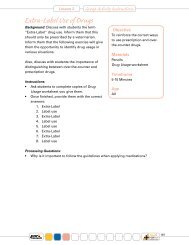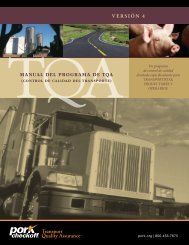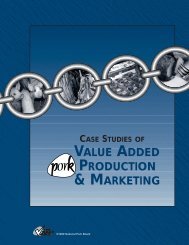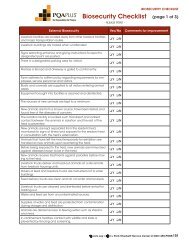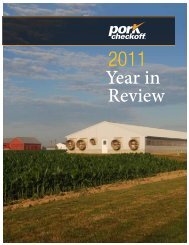The Pork Industry at a Glance - National Pork Board
The Pork Industry at a Glance - National Pork Board
The Pork Industry at a Glance - National Pork Board
You also want an ePaper? Increase the reach of your titles
YUMPU automatically turns print PDFs into web optimized ePapers that Google loves.
<strong>Pork</strong> Production<br />
Public <strong>Pork</strong><br />
Names and<br />
Environment<br />
St<strong>at</strong>s Glossary<br />
Today Health Safety Numbers<br />
Quick Facts<br />
Quick Facts<br />
History of <strong>Pork</strong><br />
<strong>The</strong> History of <strong>Pork</strong><br />
<strong>The</strong> pig d<strong>at</strong>es back 40 million years to fossils, which<br />
indic<strong>at</strong>es th<strong>at</strong> wild pig-like animals roamed forests and<br />
swamps in Europe and Asia. By 4900 B.C., pigs were<br />
domestic<strong>at</strong>ed in China, and by 1500 B.C., they were being<br />
raised in Europe.<br />
On the insistence of Queen Isabella, Christopher<br />
Columbus took eight pigs on his voyage to Cuba in 1493.<br />
However, it is Hernando de Soto who could be dubbed<br />
“the f<strong>at</strong>her of the American pork industry.” <strong>The</strong> explorer<br />
landed with America’s first 13 pigs <strong>at</strong> Tampa Bay, Fla.,<br />
in 1539.<br />
N<strong>at</strong>ive Americans reportedly became very fond of the<br />
taste of pork, resulting in some of the worst <strong>at</strong>tacks on<br />
the de Soto expedition. By the time of de Soto’s de<strong>at</strong>h<br />
three years l<strong>at</strong>er, his pig herd had grown to 700 head, not<br />
including the ones his troops had consumed, those th<strong>at</strong><br />
ran away and became wild pigs (the ancestors of today’s<br />
feral pigs or razorbacks) and those given to the N<strong>at</strong>ive<br />
Americans to help keep peace.<br />
fields of New York th<strong>at</strong> colonists who owned a pig 14 or<br />
more inches high had to put a ring in the pig’s nose. On<br />
Manh<strong>at</strong>tan Island, a long solid wall was constructed on<br />
the northern edge of the colony to control roaming herds<br />
of pigs, as well as to protect the colonists from n<strong>at</strong>ive<br />
Americans. This area is now known as Wall Street.<br />
<strong>The</strong> pig popul<strong>at</strong>ion in the Pennsylvania colony numbered<br />
in the thousands by 1660. As the 17th century<br />
closed, the typical farmer owned four or five pigs, supplying<br />
salt pork and bacon for his table, with surpluses sold<br />
as barreled pork. Following a practice th<strong>at</strong> had become<br />
common in Pennsylvania, pigs were fed a diet of n<strong>at</strong>ive<br />
American corn.<br />
After the Revolutionary War, pioneers began heading<br />
west, taking their indispensable pigs with them. A<br />
wooden cr<strong>at</strong>e filled with young pigs often was hung from<br />
the axles of prairie schooners.<br />
As western herds grew, so did the need for pork processing<br />
facilities. Packing plants began to spring up in<br />
major cities. Pigs were first commercially harvested in<br />
Cincinn<strong>at</strong>i, which became known as <strong>Pork</strong>opolis. More<br />
pork was packed there than any other place in the mid-<br />
1800s.<br />
“Drovers” Herd Pigs to Market<br />
Moving pigs to market in the 1850s was no small<br />
undertaking. “Drovers” herded their pigs along trails,<br />
which l<strong>at</strong>er developed into railroad routes. Between<br />
America’s <strong>Pork</strong> <strong>Industry</strong> Had Begun<br />
Pig production spread throughout the new colonies.<br />
Hernando Cortez introduced hogs to New Mexico in<br />
1600, and Sir Walter Raleigh brought sows to Jamestown<br />
Colony, now in Virginia, in 1607.<br />
Semi-wild pigs conducted such rampages in the grain<br />
History of <strong>Pork</strong><br />
35





